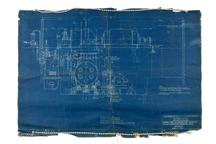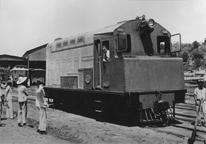

English Electric Company Limited
The English Electric Company was formed on 14th December 1918 and over the following year acquired Dick, Kerr & Company of Preston, Willans & Robinson of Rugby, the Phoenix Dynamo Manufacturing Company of Bradford, and Coventry Ordnance Works. After the First World War the various German owned Siemens works were distributed to different UK companies and in November 1919 English Electric acquired the Siemens Brothers Dynamo Works at Stafford, which became the company headquarters in 1931.
Coventry Ordnance, primary output naval guns, did not feature in the gradual product rationalisation which took place between the First World and Second world Wars. Willans & Robinson’s Rugby works specialised in prime movers, steam, hydro and internal combustion, and their Stafford works on power station and distribution electrics, including transformers and large electric machines for applications such as mining and steel works. Dick Kerr & Company continued building equipment and vehicles for bus, tram and railway applications with the Phoenix Dynamo Manufacturing Company concentrating on medium and small electrical machines. Involvement with aircraft continued a small scale. By 1929 the company was in financial trouble and an American syndicate fronted by Lazard Bros. put in new capital. In 1930 Westinghouse of Pittsburgh entered into an agreement with the company for the exchange of technical information relating to steam turbines and electrical apparatus. This cooperation continued into the 1950s.
1930 saw the closure of Preston West works and the transfer of traction electrical design and manufacture to the Phoenix Dynamo Manufacturing works. The Westinghouse influence included top management changes with Sir H Mensforth becoming chairman and George Nelson managing director. Both had been with British Westinghouse at Trafford Park. The early 1930s saw a remarkable improvement in the company’s finances and domestic appliance manufacture was started at Bradford and Stafford. In 1936 they began production of diesel locomotives at Preston and were later involved in the production of the Deltic locomotive for British Rail, presaging the end of steam traction in the UK.
Extensive shadow factory building for war production commenced in the late 1930’s, including at Preston East works and Salmesbury for aircraft production and at East Lancashire Road, Liverpool for D. Napier aero engines. A large variety of military equipment built during the war included thousands of Cromwell tanks from Stafford and over 3000 Handley Page Hampden and Halifax bombers from Preston and Salmesbury. After the war manufacture of smaller products from Bradford and Stafford moved to the large Liverpool works. This included electrical distribution transformers, switchgear, fuse gear, fractional horsepower motors and domestic appliances. Napier’s continued engine manufacture with the development of the ’Deltic’ diesel engine, mainly for marine applications. The nearby Netherton works took over the manufacture of large hydro-electric turbines and generators from Willans and Stafford.
In 1942 English Electric acquired D. Napier & Son Ltd and Marconi in 1946. The company went on to extend their railway interests with the acquisition of the Vulcan Foundry and Robert Stephenson and Hawthorn Ltd in 1955. The company tried to take over The General Electric Company (GEC) in 1960 but failed.
Traction manufacture, but not the offices, moved back to Preston East works and ‘K’, ‘RK’ and ‘V’ engine design and manufacture moved from Willans to Preston West works which was now also used for locomotive building. Kidsgrove works in Stafford made industrial controls and for a while was a major player in the UK computer industry, merging with Leo Computers and then into ICL. Train performance calculations were an early user of the mid-fifties ‘Deuce’ computer. Preston also became a major player in the aircraft industry taking over the wartime RAF/USAF base at Warton aerodrome - major design and manufacture contracts included Canberra bombers and Lightning fighters. Rationalisation in the 1960s resulted in English Electric Aviation becoming 40% of the new British Aircraft Corporation.
In 1961 English Electric took over Dorman Diesels Ltd which in turn had acquired W. G. Bagnall Ltd. In 1966 English Electric Diesels merged with Ruston and Hornsby which already included Paxmans. This company eventually became GEC Diesels. Elliott Automation was acquired in 1967. The following year GEC took over English Electric, ending its independent existence.


